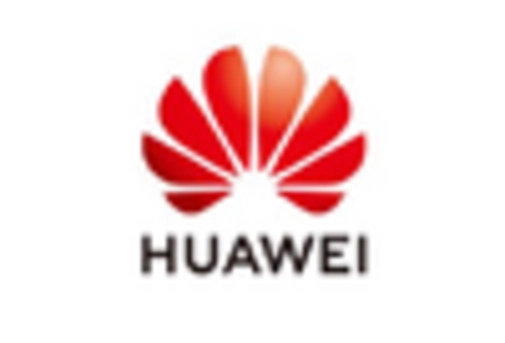The wireless network infrastructure ecosystem market in Canada is characterized by a dynamic competitive landscape, driven by rapid technological advancements and increasing demand for high-speed connectivity. Major players such as Rogers Communications (CA), Bell Canada (CA), and Telus Corporation (CA) are at the forefront, each adopting distinct strategies to enhance their market positioning. Rogers Communications (CA) has focused on expanding its 5G network capabilities, emphasizing innovation in service delivery and customer experience. Bell Canada (CA), on the other hand, has pursued aggressive mergers and acquisitions to consolidate its market presence, while Telus Corporation (CA) has prioritized digital transformation initiatives to improve operational efficiency and customer engagement. Collectively, these strategies contribute to a competitive environment that is increasingly centered around technological innovation and customer-centric solutions.
Key business tactics employed by these companies include localizing manufacturing and optimizing supply chains to enhance responsiveness to market demands. The market structure appears moderately fragmented, with several regional players like Shaw Communications (CA) and Quebecor Inc. (CA) also vying for market share. The collective influence of these key players shapes a competitive landscape where agility and adaptability are paramount, as companies strive to meet the evolving needs of consumers and businesses alike.
In November 2025, Rogers Communications (CA) announced a strategic partnership with a leading technology firm to enhance its 5G infrastructure. This collaboration is expected to accelerate the deployment of advanced network solutions, positioning Rogers as a leader in next-generation connectivity. The strategic importance of this partnership lies in its potential to improve service reliability and expand coverage, thereby attracting a broader customer base.
In October 2025, Bell Canada (CA) completed the acquisition of a regional telecommunications provider, significantly bolstering its market share in the wireless sector. This acquisition is strategically vital as it not only enhances Bell's infrastructure capabilities but also allows for greater economies of scale, ultimately benefiting consumers through improved service offerings and competitive pricing.
In September 2025, Telus Corporation (CA) launched an innovative AI-driven platform aimed at optimizing network performance and customer service. This initiative reflects Telus's commitment to integrating cutting-edge technology into its operations, which is likely to enhance customer satisfaction and operational efficiency. The strategic importance of this move lies in its potential to differentiate Telus in a crowded market, as AI capabilities become increasingly critical in managing complex network environments.
As of December 2025, current competitive trends in the wireless network infrastructure ecosystem are heavily influenced by digitalization, sustainability, and AI integration. Strategic alliances are becoming more prevalent, as companies recognize the need for collaboration to drive innovation and enhance service delivery. Looking ahead, competitive differentiation is expected to evolve, with a notable shift from price-based competition to a focus on innovation, technology, and supply chain reliability. This transition underscores the importance of agility and responsiveness in a rapidly changing market landscape.





















Leave a Comment